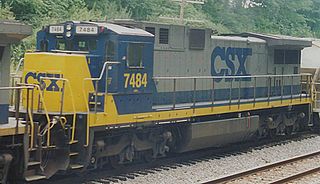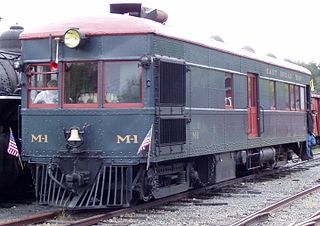
A locomotive or engine is a rail transport vehicle that provides the motive power for a train. If a locomotive is capable of carrying a payload, it is usually rather referred to as a multiple unit, motor coach, railcar or power car; the use of these self-propelled vehicles is increasingly common for passenger trains, but rare for freight.

A hybrid vehicle is one that uses two or more distinct types of power, such as submarines that use diesel when surfaced and batteries when submerged. Other means to store energy include pressurized fluid in hydraulic hybrids.

A diesel locomotive is a type of railway locomotive in which the prime mover is a diesel engine. Several types of diesel locomotives have been developed, differing mainly in the means by which mechanical power is conveyed to the driving wheels.

General Electric Genesis is a series of passenger diesel locomotives produced by GE Transportation, then a subsidiary of General Electric. Between 1992 and 2001, a total of 321 units were built for Amtrak, Metro-North, and Via Rail.

The McKeen Motor Car Company of Omaha, Nebraska, was a builder of internal combustion-engined railroad motor cars (railcars), constructing 152 between 1905 and 1917. Founded by William McKeen, the Union Pacific Railroad's Superintendent of Motive Power and Machinery, the company was essentially an offshoot of the Union Pacific and the first cars were constructed by the UP before McKeen leased shop space in the UP's Omaha Shops in Omaha, Nebraska. The UP had asked him to develop a way of running small passenger trains more economically and McKeen produced a design that was ahead of its time. Unfortunately, internal combustion engine technology was not and the McKeen cars never found a truly reliable powerplant.

The EMD F2 was a freight-hauling diesel locomotive built by General Motors Electro-Motive Division between July 1946 and November 1946. It succeeded the FT model in GM-EMD's F-unit sequence, and was replaced in turn by the F3. The F2 was in many respects a transitional type between those two; it kept the 1,350 hp (1,010 kW) rated D8 generator from the FT due to late development of the new D12 generator intended for the F3, but in a revised carbody design and internal layout that would be continued through the rest of the F-unit series. 74 cab-equipped lead A units and 30 cabless booster B units were produced.

The Evolution Series is a line of diesel locomotives built by GE Transportation Systems, initially designed to meet the U.S. EPA's Tier 2 locomotive emissions standards that took effect in 2005. The first pre-production units were built in 2003. Evolution Series locomotives are equipped with either AC or DC traction motors, depending on the customer's preference. All are powered by the GE GEVO engine.

The Minneapolis, Northfield and Southern Railway was an 87-mile (140 km) long American shortline railroad connecting Minneapolis and Northfield, Minnesota. It was incorporated in 1918 to take over the trackage of the former Minneapolis, St. Paul, Rochester and Dubuque Electric Traction Company, also known as the Dan Patch Lines. On June 2, 1982, it was acquired by the Soo Line Railroad, which operated it as a separate railroad until merging it on January 1, 1986 along with the Chicago, Milwaukee, St. Paul and Pacific Railroad.
Progress Rail Locomotives, doing business as Electro-Motive Diesel (EMD), is an American manufacturer of diesel-electric locomotives, locomotive products and diesel engines for the rail industry. The company is owned by Caterpillar through its subsidiary Progress Rail.

The GE C39-8 is a 6-axle diesel-electric locomotive model built by GE Transportation Systems between 1984 and 1987. It is part of the GE Dash 8 Series of freight locomotives.

The GE Dash 8-32BWH, also known as the P32-8BWH, B32-8WH, or P32-8, is a passenger train locomotive used by Amtrak, based on GE's Dash 8 series of freight train locomotives. Built in 1991, they were the first locomotives purchased to replace the EMD F40PH.

The GE C40-8W is a 6-axle diesel-electric locomotive built by GE Transportation Systems from 1989 to 1994. Often referred to as a Dash 8-40CW, it is part of the GE Dash 8 Series of freight locomotives. This locomotive model is distinguished from the predecessor Dash 8-40C by the addition of a newer "wide" or "safety" cab. A cowl-bodied version of this locomotive, built only for the Canadian market, was the GE Dash 8-40CM.

Doodlebug or hoodlebug is a nickname in the United States for a type of self-propelled railcar most commonly configured to carry both passengers and freight, often dedicated baggage, mail or express, as in a combine. The name is said to have derived from the insect-like appearance of the units, as well as the slow speeds at which they would doddle or "doodle" down the tracks. Early models were usually powered by a gasoline engine, with either a mechanical drive train or a generator providing electricity to traction motors ("gas-electrics"). In later years, it was common for doodlebugs to be repowered with a diesel engine.
The MK5000C is a 5,000 hp (3.7 MW) North American diesel-electric locomotive developed by MK Rail. At the time of its introduction in 1994, the MK5000C was the most powerful single prime mover diesel-electric locomotive ever made, a title it would hold for only for one year until GE Transportation released its competing 6,000 hp (4.5 MW) AC6000CW model in 1995.
A hybrid train is a locomotive, railcar or train that uses an onboard rechargeable energy storage system (RESS), placed between the power source and the traction transmission system connected to the wheels. Since most diesel locomotives are diesel-electric, they have all the components of a series hybrid transmission except the storage battery, making this a relatively simple prospect.

The GE C40-8M is a 6-axle diesel locomotive built by GE Transportation Systems from 1990 to 1994. It is part of the GE Dash 8 Series of freight locomotives, and is often referred to as a Dash 8-40CM.

The Dash 9 Series is a line of diesel locomotives built by GE Transportation Systems. It replaced the Dash 8 Series in the mid-1990s, and was superseded by the Evolution Series in the mid-2000s. Dash 9 series locomotives are some of the most common in the United States.
Petrol–electric transmission or gasoline–electric transmission or gas–electric transmission is a transmission system for vehicles powered by petrol engines. Petrol-electric transmission was used for a variety of applications in road, rail, and marine transport, in the early 20th century. After World War I, it was largely superseded by diesel-electric transmission, a similar transmission system used for diesel engines; but petrol-electric has become popular again in the 21st century in hybrid electric vehicles.

An internal combustion locomotive is a type of railway locomotive that produces its pulling power using an internal combustion engine. These locomotives are fuelled by burning fossil fuels, most commonly oil or gasoline, to produce rotational power which is transmitted to the locomotive's driving wheels by various direct or indirect transmission mechanisms. The fuel is carried on the locomotive.















